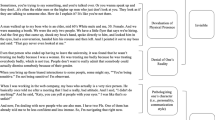Abstract
Nationally, non-tenure-track faculty (NTTF) represent the new majority. Efforts to move the full-time NTTF role from expendable labor to sustainable professional position have led to improvements in policy and working conditions at many institutions. Still, the profession broadly has just begun to grapple with the implications of this shifting labor market on aspects of the profession traditionally reserved for tenure system faculty, such as collegiality. In this qualitative study we use Bess’s (High Educ Handb Theory Res 8:1–36, 1992) framework of structure, culture, and behavior to analyze the collegial expectations of 38 full-time, NTTF members. Participant accounts point to a desire for parity despite differentiation, and highlight the fundamental contradictions of a professional virtue that requires the independence of faculty for it to be fully expressed.
Similar content being viewed by others
References
Baldwin, R. G., & Chronister, J. L. (2001). Teaching without tenure. Baltimore, MD: The Johns Hopkins University Press.
Barnes, L. L. B., Agago, M. O., & Coombs, W. T. (1998). Effects of job-related stress on faculty intention to leave academia. Research in Higher Education, 39(1), 457–469.
Bess, J. L. (1992). Collegiality: Toward a clarification of meaning and function. Higher Education: Handbook of Theory and Research, 8, 1–36.
Bode, R. K. (1999). Mentoring and collegiality. In R. J. Menges & Associates (Eds.), Faculty in new jobs: A guide to settling in, becoming established, and building institutional rapport. San Francisco, CA: Jossey-Bass.
Boice, R. (1992). The new faculty member: Supporting and fostering professional development. San Francisco, CA: Jossey-Bass.
Cipriano, R. E. (2011). Facilitating a collegial department in higher education: Strategies for success. San Fransciso, CA: Jossey-Bass.
Collins, R. (2004). Interaction ritual chains. Princeton, NJ: Princeton University Press.
Cross, J. G., & Goldenberg, E. N. (2009). Off-track profs: Nontenured teachers in higher education. Cambridge, MA: The MIT Press.
Gappa, J. M., & Leslie, D. W. (1993). The invisible faculty: Improving the status of part-timers in higher education. San Francisco, CA: Jossey-Bass.
Gappa, J. M., Austin, A. E., & Trice, A. G. (2005). Rethinking academic work and workplaces. Change, 37(6), 32–39.
Hearn, J. C., & Deupree, M. M. (2013). Here today, gone tomorrow: The increasingly contingent faculty workforce. Retrieved from TIAA-CREF Institute web site https://www.tiaa-crefinstitute.org/public/institute/research/advancing_higher_education/contingentfaculty0313.html.
Hollenshead, C., Waltman, J., August, L., Miller, J., Smith, G., & Bell, A. (2007). Making the best of both worlds: Findings from a national institution-level survey of non-tenure track faculty. Retrieved from the University of Michigan Center for the Education of Women. http://www.cew.umich.edu/sites/default/files/CEW%20Final%20Report%20PP34.pdf.
Kezar, A. (2012a). Embracing non-tenure-track faculty: Making change to support the new majority. New York, NY: Routledge.
Kezar, A. (2012b). Spanning the great divide between tenure-track and non-tenure-track faculty. Change, 44(6), 6–13.
Kezar, A. (2013). Examining non-tenure track faculty perceptions of how departmental policies and practices shape their performance and ability to create student learning at four-year institutions. Research in Higher Education, 54(5), 571–598. doi:10.1007/s11162-013-9288-5.
Kezar, A., & Maxey, D. (2015). Adapting by design: Creating faculty roles and defining faculty work to ensure an intentional future for colleges and universities. Retrieved from The Delphi Project web site http://www.uscrossier.org/pullias/wp-content/uploads/2015/06/DELPHI-PROJECT_ADAPTING-BY-DESIGN_2ED.pdf.
Kezar, A., & Sam, C. (2010). Non-tenure-track faculty in higher education. ASHE higher education report (Vol. 36, number 3). San Francisco, CA: Jossey-Bass.
Levin, J. S., & Shaker, G. G. (2011). The hybrid and dualistic identity of full-time non-tenure-track faculty. American Behavioral Scientist, 55(11), 1461–1484. doi:10.1177/0002764211409382.
Lincoln, Y. S., & Guba, E. G. (1985). Naturalistic inquiry. Beverly Hills, CA: Sage.
Mangiardi, J., & Pellegrino, E. (1992). Collegiality: What is it? Bulletin of the New York Academy of Medicine, 68, 292–296.
Morrison, J. D. (2008). Faculty governance and nontenure-track appointments. New Directions for Higher Education, 143, 21–27.
Ott, M., & Cisneros, J. (2015). Understanding the changing faculty workforce in higher education: A comparison of full-time non-tenure track and tenure line experiences. Education Policy Analysis Archives, 23(90), 1–28.
Rice, R. E. (1986). The academic profession in transition: Toward a new social fiction. Teaching Sociology, 14(1), 12–23. doi:10.2307/1318295.
Rice, R. E., Sorcinelli, M. D., & Austin, A. E. (2000). Heeding new voices: Academic careers for a new generation (Vol. 7)., New pathways working paper series Washington, DC: American Association of Higher Education.
Richards, L. (2009). Handling qualitative data: A practical guide (2nd ed.). Thousand Oaks, CA: Sage Publications.
Saldana, J. (2013). The coding manual for qualitative researchers (2nd ed.). Los Angeles, CA: Sage Publications.
Sorcinelli, M. D. & Austin, A. E. (1992). Developing new and junior faculty. New Directions for Teaching and Learning, No. 48. San Francisco, CA: Jossey-Bass.
Stake, R. E. (1995). The art of case study research. London: Sage Publications.
Tierney, W. G., & Bensimon, E. M. (1996). Promotion and tenure: Community and socialization in academe. Albany, NY: State University of New York Press.
Waltman, J., Bergom, I., Hollenshead, C., Miller, J., & August, L. (2012). Factors contributing to job satisfaction and dissatisfaction among non-tenure-track faculty. The Journal of Higher Education, 83(3), 411–434.
Author information
Authors and Affiliations
Corresponding author
Rights and permissions
About this article
Cite this article
Alleman, N.F., Haviland, D. “I expect to be engaged as an equal”: collegiality expectations of full-time, non-tenure-track faculty members. High Educ 74, 527–542 (2017). https://doi.org/10.1007/s10734-016-0062-4
Published:
Issue Date:
DOI: https://doi.org/10.1007/s10734-016-0062-4




